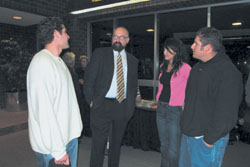Robert Torosian
Staff Writer
2001 marks the 1700th year anniversary of the proclamation of Christianity as the State Religion of Armenia and the Fresno State Armenian Studies Program is doing everything it can to help educate students about this important event.

The ASP organized a three-part lecture series this Fall, “The Conversion of Armenia to Christianity,” to be given by Dr. Robert H. Hewsen, Henry S. Khanzadian Kazan Visiting Professor for the Armenian Studies Program. Dr. Hewsen received his Ph.D. from Georgetown University and has spent the last 33 years teaching both Byzantine and Russian history at Rowan University of New Jersey.
On October 4th, Dr. Hewsen gave the first lecture of the series, “Armenia on the Eve of the Conversion,” to Fresno State students, faculty, and community members. Dr. Hewsen started off his lecture by not talking just about the conversion of Armenians to Christianity, but he took a step further back and began by discussing the origins of the Armenian people. He talked about the geography of Armenia, the people, the culture and the political system that existed prior to the Christianization, which took place in the early fourth century AD.
The conversion of Armenia to Christianity is said to have occurred in 301 AD, but there were many different factors which led to the conversion. Dr. Hewsen talked about three early Armenian kingdoms, those of the Yervanduni, the Arshakuni, and the Arsacid dynasty. He explained the three dynasties and talked about each of them relating to their religion, political system, and the area ruled by the different dynasties.
Something that everyone wanted to know was what kind of religion the Armenian people practiced before being converted to Christianity. Dr. Hewsen did a great job explaining in detail the pagan religion of the Armenians before the conversion. He explained Zoroastrianism, which was originally a Persian religion. Zoroastrianism, according to Professor Hewsen, has very unique characteristics that appealed to the Armenian people. It was deep rooted in the Armenian people, as it was their religion for about 800 years before Christianity. Zoroastrianism involves worshipping gods and goddesses, the most important of whom was Anahit, the main goddess of the Armenian people. She was the goddess of fertility, beauty, and wisdom. Armenians built many shrines for the gods and goddesses, but after 301 AD, most of the shrines were torn down and Christian churches were built on the sites.
History would not exist today if historians had not spent a lot of time writing down what was happening at the time, but some of the historians’ works can also be questioned. As Dr. Hewsen explained, the history of the Armenian conversion to Christianity was recorded by an Armenian historian named Agathangelos, who claimed to be an eyewitness to the conversion. Recent evidence has shown that it would have been impossible for him to be an eyewitness and it places his account in the 5th century.
In his book History of the Armenians, Agathangelos tells the story of the conversion of Armenians to Christianity. According to him, the king of Armenia at the time, King Trdat, had martyred 32 Christian nuns who had fled to Armenia to escape from Emperor Diocletian. King Trdat was in love with one of the nuns, named Hripsime, and after she refused to marry the king, he had all 32 nuns martyred. According to Agathangelos, the king then started acting like a wild boar. A Christian priest named Gregory, who had been held prisoner by the king for 13 years, was brought to the king. Gregory prayed with the king for forty days and, as the story goes, the king was healed. He ordered that Christianity become the state religion of Armenia. The date of the conversion is controversial to scholars, but it is widely accepted (the Armenian Church recognizes this date) that it occurred in 301 AD.
After this lecture, people received so much information in such great detail that it not only taught them about the conversion of the Armenians to Christianity but also gave them a concise summary of Armenian history up to the event.
The aims of the Society for Armenian Studies are to promote the study of Armenian culture and society, including history, language, literature, and social, political, and economic questions; to facilitate the exchange of scholarly information pertaining to Armenian studies around the world; and to sponsor panels and conferences on Armenian studies.
The programs of the Society include publication of a Newsletter (www.csufresno.edu/ArmenianStudies/SAS/index.htm) on the Society’s activities and on current research on Armenia; publication of the Journal of the Society for Armenian Studies, encouragement, sponsorship and publication of research on all facets of Armenian culture and society; and such other activities as the SAS council may from time to time determine.
The Secretariat of the Society is located at the Armenian Studies Program of California State University, Fresno. For membership information please contact the Armenian Studies Program, 5245 N. Backer Ave., PB4, Fresno, CA 93740-8001; telephone 559-278-2669.
 Hye Sharzhoom Armenian Action
Hye Sharzhoom Armenian Action